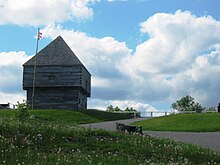St. John River expedition
| St. John River expedition | |||||||
|---|---|---|---|---|---|---|---|
| Part of the American Revolutionary War | |||||||
 Admiral Mariot Arbuthnot, Lieutenant Governor of Nova Scotia - sent troops to end John Allan's operations | |||||||
| |||||||
| Belligerents | |||||||
|
|
| ||||||
| Commanders and leaders | |||||||
| John Allan |
Gilfred Studholme Michael Francklin | ||||||
| Strength | |||||||
| about 100 militia | 120 troops | ||||||
| Casualties and losses | |||||||
| 12 killed | 1 killed | ||||||
The St. John River expedition was an attempt by a small number of militia commanded by John Allan to bring the American Revolutionary War to Nova Scotia in late 1777. With minimal logistical support from Massachusetts and approximately 100 volunteer militia and Natives, Allan's forces occupied the small settlement at the mouth of the Saint John River (present-day Saint John, New Brunswick, then part of Sunbury County, Nova Scotia) in June 1777.[1]
The settlement's defense was weakened by the war effort and that Americans quickly occupied it and took prisoner British sympathizers. Almost a month later, under command of Brigade Major Studholme and Colonel Francklin, British forces successfully drove off the occupying Americans, forcing Allan to make a difficult overland journey back to Machias, Maine. Allan's incursion was the last significant American land-based assault on Nova Scotia during the war, which remained loyal throughout the war.
Historical context

In 1776, when the
In early 1777,
Expedition
Colonel Allan left Machias with a party in four whale boats and four birch canoes, on May 30, 1777. The party, including Indians, numbered 43 men. More than half of Allan's troops had served under Eddy at Fort Cumberland.
Allan's intention of establishing a permanent post was cut short when British authorities in Halifax learned of his operation from a Loyalist who escaped Allan's men.
Aftermath

Col. Allan's untiring efforts to gain the friendship and support of the Indians, during the four weeks he had been at Aukpaque was somewhat successful. There was a significant exodus of Maliseet from the region to join the American forces at Machias.[11] On Sunday, July 13, 1777, a party of between 400 and 500 men, women, and children, embarked in 128 canoes from the Old Fort Meduetic (8 miles below Woodstock) for Machias. The party arrived at a very opportune moment for the Americans, and afforded material assistance in the defence of that post during the attack made by Sir George Collier on the 13th to 15 August. The British did only minimal damage to the place, and the services of the Indians on the occasion earned for them the thanks of the council of Massachusetts.[1]
After Allan's expedition the British settlers on the Saint John demanded a better defense from Halifax. In response, Major Studholme was sent to provide a permanent military presence (fortuitously frustrating plans by raiders from Machias to further plunder the Saint John settlement), and
Nova Scotia was not subjected again to land-based invasions, but there continued to be raiding by
See also
- American Revolution - Nova Scotia theatre
- Military history of Nova Scotia
- Military history of the Maliseet people
References
- London Gazette 19 August 1777
- Craig, Calvin (1989) The Young Emigrants: Craigs of Magaguadavic
- Gwyn, Julian (2004). Frigates and Foremasts: The North American Squadron in Nova Scotia Waters, 1745–1815. Vancouver, BC: UBC Press. OCLC 144078613.
- Hannay, James (1909). History of New Brunswick. Saint John, NB: John A. Bowes.
- Leamon, James S (1995). Revolution Downeast: The War for American Independence in Maine. University of Massachusetts Press. ISBN 978-0-87023-959-5.
- Kidder, Frederic, ed. (1867). Military Operations in Eastern Maine and Nova Scotia During the Revolution. J. Munsell. This book contains Eddy's report detailing the action through early January 1777.
- Porter, Joseph Whitcomb (1877). Memoir of Col. Jonathan Eddy of Eddington, ME. Sprague, Owen & Nash. This book also contains Eddy's report of January 1777 as well as additional documents and reports.
- OCLC 422037263.
- Sarty, Roger Sarty; Knight, Doug. Saint John Fortification: 1630-1956s. Goose Lane Editions. 2003.
- Stacy, Kim (1994). No One Harms Me With Impunity - the History, Organization and Biographies of the 84th Highland Regiment (Royal Highland Emigrants) and Young Royal Highlanders during the Revolutionary War 1775-1784. Unpublished manuscript.
- Godfrey, W.G. (1979). "Studholme, Gilfred". In Halpenny, Francess G (ed.). Dictionary of Canadian Biography. Vol. IV (1771–1800) (online ed.). University of Toronto Press. Retrieved 2011-10-08.
- Endnotes
- ^ a b c d Rev. W. O. Raymond
- ^ James Hannay. History of New Brunswick. St. John, N.B.: John A. Bowes, 1909. p. 98
- ^ p. 4
- ^ a b Roger Sarty and Doug Knight. p 33
- ^ Leamon, pp. 90–91
- ^ Hannay, p. 117
- ^ Gwyn, p. 64
- ^ Hannay, p. 118
- ^ Roger Sarty and Doug Knight. p. 34
- ^ For information on the 84th Regiment see Stacy, pp. 26–27; Craig, p. 54.
- ^ Hannay, p. 119
